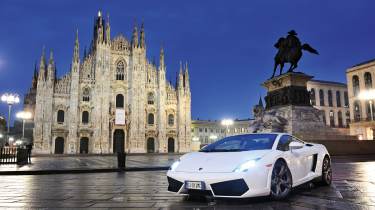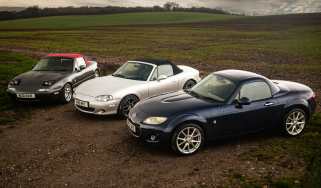Lamborghini Gallardo LP550-2 50th anniversary tour preview
Ahead of the Lamborghini 50th anniversary tour, Henry Catchpole drove the proposed route in the rear-drive Gallardo LP550-2.
A couple of police cars drive past very slowly. Dean and I freeze, trying to look as nonchalant as we can in a bright white Gallardo parked completely illegally in a pedestrian zone outside Milan Cathedral. Thankfully, with the clock reading 5.36am, the Punto’s law-enforcing occupants are more concerned about getting their first coffee of the early shift (or possibly the last of the late one). And let’s face it, we’re in a Lamborghini in Italy – surely that’s like having an F1 access-all-areas pass? Surely we can do what we like? Maybe we can, but don’t hold me to it. Anyway, over the next couple of days, we’re going to find out…
Next year will mark the golden jubilee of Automobili Lamborghini, and 50 years after Ferruccio famously became dissatisfied with his Ferrari’s clutch and the subsequent response he received from Enzo when he challenged him on it, there’s going to be a party.
Central to this shindig will be a ’grand tour’ for 300 cars and their owners around Italy, with stops in historic locations, nights in sumptuous hotels and ear-melting cavalcades over historic passes. Of course, something like that needs planning, it needs a recce of the roads and someone heavy (sorry, big-boned) like snapper Dean Smith to test the beds by using them as trampolines, which is how we find ourselves as a pair of guinea pigs. We’re guinea pigs in a Gallardo LP550-2, though, so we’re pretty smug guinea pigs.
The hotel in the centre of Milan last night was very much an Aventador kind of hotel, with riotous colours and bemusing fabrics everywhere. A red-framed glass façade that screamed modernity amongst the historic porticos topped it all off. I felt I should have tried all 15 of the test tube-style soaps in my room, but settled on smelling like orange blossom and mouthwash (come to think of it, perhaps that second one was mouthwash). After taking our early shots outside the Duomo, we make a beeline past the fashion houses and head for the hills. It’s hard to creep out of a city in a Gallardo – something about the tall buildings and the opening of exhaust flaps at 4000rpm just seems to rob you of any stealth. I wouldn’t mind it as an alarm clock though.
After a quick blast down the A1 to Piacenza, we jab Bobbio into the satnav as we head towards Genoa and the north-west coast of Italy. The mist is still hanging in spectral wreaths around the hills as we head along the SS45, which meanders along the path of the Trebbia river. It’s a part of Italy I’ve never been to before and it looks very different to the plains of Emilia-Romagna or the soft hills of Tuscany.
Just after Bobbio, in a town called Marsaglia, we turn left onto the SS586. This road is narrower (it’d be a tight fit for a Diablo in places) and the landscape intensifies. Steep-sided valleys are covered in verdant trees, with grey vertical slabs of rock the only real punctuation in the sea of green. This is the Aveto Natural Regional Park, which Ernest Hemingway described as ‘the most beautiful in the world’. It has a lost world feeling to it – you almost wouldn’t be surprised if there were the odd velociraptor wandering about amongst the trees.
The Gallardo that we’re in is arguably something of a dinosaur itself, equipped as it is with three pedals and a manual gearbox. But to me, this rarest of supercars is also one of the best; the shift action is absolutely delicious. You’ll find almost the same tactile delight in an Audi R8 manual, but the smooth metal cue ball mounted on top of the gearstick somehow lifts the Lambo’s shift action a notch higher still. My favourite change is from second to third gear; a bit of pressure to slide it out of second, ease the load on your palm very slightly to let the natural centring spring guide the stick across the gate and then push forwards again on the shiny bauble into the oiled resistance of third. Get it right in one swift motion and a loud, pure clink like the clashing of a two swords fills the cabin as the gearstick glances off the prong separating first from third. No matter how fast you move your hand, it’s much slower than even the worst e-gear shift, but it’s also so much more satisfying.
Eventually, after stopping briefly on a slender fairytale bridge that’s too gorgeous to pass by, the trees begin to recede as we near the coast at Chiavari. We head onto the autostrada as it’s the best option for the blast down to our next destination, and it’s a good stretch, with plenty of tunnels to orchestrate some mini-concerts with the 542bhp V10. We’re on course for Forte dei Marmi (which translates to Fort of Marble), holiday destination of the Fiat-founding Agnelli family and the first stop-over for the jubilee tour. It’s the Tyrrhenian coast’s answer to Monaco, with enough designer boutiques to keep a WAG amused for a week, but Dean and I haven’t got time (or room in the Gallardo) for any shopping as we’re cramming two days of driving into one, aiming to get to Rome by tonight.
The focus of the second day of next year’s tour is Tuscany. There’s a quick dive inland to Pisa before heading on down the coast towards Castagneto Carducci. From here the road wriggles inland on a stretch of tarmac narrow enough to be devoid of road markings. Initially this appears to be a potentially bad place for a supercar (even one with the relatively diminutive footprint of the Gallardo), as you twist and turn through a dark rabbit warren of trees, but stick with it, because after Massa Marittima the road melts outwards, the sky reappears and you find yourself released into a Tuscan wonderland of soft light and rustic hillsides topped with cypress-guarded farms. There are straights long enough to land an Airbus on too, which give the Gallardo a chance to stretch its legs. There’s probably enough room to start knocking on the door of the 550-2’s 199mph top speed, but the surface is sufficiently cambered and broken for me to chicken out after a significant wobble at 150.
As dusk falls and the towered hill towns begin twinkling on their perches, we swing south to Grosseto and then on towards Rome, with a thunderstorm breaking just as we hit the main road. Eventually the satnav leads us past the Vatican, up one of Rome’s seven hills and deposits us in front of the grand entrance to the Westin Excelsior just after 10pm. We feel distinctly underdressed (the image is one of two dishevelled hitch-hikers who have won a supercar and accommodation in a hotel. All we’re missing is the mongrel with some string as its lead).
After some pizza and just enough sleep to restore our faculties, we pack up, do a quick early morning drive-by of the Colosseum and head north amongst the gradually swelling rush-hour traffic.
At pottering speeds the 550-2’s ride is resolutely firm, something highlighted by the vast number of cobbles that seem to pave the streets of major Italian cities (something I’d never really noticed before). Impressively, despite my wincing a good deal on the first day, the Gallardo’s angular nose never appears to be in danger of scuffing like some of Maranello’s finest. The passive dampers are definitely set up with hard driving in mind, though, and the car comes alive when you take it beyond seven-tenths; the firm springs give you the security and confidence to really lean on them in the corners and know that they will support you.
We follow the SS2 to Monterosi then the SP1 to Viterbo, turn back onto the SS2 towards Montefiascone then take the SS71 to the Umbrian town of Orvieto. The final section of this features a great set of hairpins that wind downhill with a fantastic view of Orvieto’s skyline, which is dominated by the incredible Gothic façade of its cathedral. It’s too good a view to miss so we take it in and then reward ourselves with an unconventional but delicious breakfast of espresso and ice cream (one scoop Kinder, one scoop panna cotta).
Like a Dolmio advert come to life, a tanned and weathered face, skin lined from its 80-odd years of emotion, cracks into a broad smile as it turns from the vines at the side of the road. He has no doubt heard the Gallardo from some distance because the SS71 north of Orvieto is proving to be rather good. Unbeknownst to us, it’s just about to get even better. It’s uphill and wide enough, with good cambers and that perfect flow to the radii of the corners that lets you get into a rhythm.
The rear-drive 550-2’s steering has more clarity than a four-wheel-drive Gallardo’s, but there is still some weight to it (something you notice in your left hand, which bears the loadings when you change gear). The weight is there instantly on initial turn-in, before fading and then coming back to you as you push through a corner.
The road surface has fared even worse than the old man’s face over the years and is so pitted and broken that at times the rear Pirelli Corsas are breaking traction far earlier than you might expect. Get on the throttle hard at the exit of a corner and one of three things will happen: Sometimes you’ll feel the tyres dig deep into the positive camber of the road, wall of death-style, and slingshot you out like the car has just hooked an elbow round a lamp post on the inside of the corner. Or the wheels might spin up on the broken surface, but not enough for the tail to get really loose or require any opposite lock, and you can keep them spinning on the edge of traction to ride out the nano-slide until the road surface improves. Or you might just end up with a good old-fashioned drift in a V10-engined Lamborghini. As you do. This continues all the way up the hillside, sun out, broad grins on faces. It’s easy to see why Ferruccio so readily retired to Umbria.
The rest of the day is spent avoiding motorways and hammering across the countryside to Arezzo and Borgo san Lorenzo, past the Mugello race circuit, up the Passo del Giogo to Firenzuola, and finally onto the familiar territory of the Futa and Raticosa passes for the run to Bologna and the humble-sounding Grand Hotel Majestic. The red city of Bologna, with its colonnaded shopping arcades, is an appropriate place to end the day as it’s not only where Ferruccio Lamborghini studied, it’s also where he was buried upon his passing in 1993, almost two decades after he relinquished control of the company.
And from his resting place it seems only right and proper the following morning to make a small detour en route to Sant’Agata to go to his birthplace. The small, slightly run-down town of Renazzo is near Cento, just to the north of the Lamborghini factory. There’s both a Via Lamborghini, where we appropriately find one of his tractors, and also a piazza named after him, with a slightly futurist sculpture that includes a bull and a Miura bonnet. Then it’s just a few minutes along what I like to imagine was Ferruccio’s route to his office to what will be, on May 11, 2013, the end point of the jubilee tour route.
Driving a supercar in Italy is one of the best things in the world for anyone with a fluid ounce of petrol in their veins. Sadly it’s rare to see anything with more than a handful of cylinders in Italy these days; apart from the occasional original Fiat 500, a lone 997 Carrera S was as interesting as the other traffic got, the bhp-based tax system meaning all the home-turf exotica has been squirreled away. So what 300 Lamborghinis (I think a stampede would be the collective noun) will look like next summer, I can barely imagine. Think of the sound as Miura follows Murciélago follows Diablo GT through the tunnels to Forte dei Marmi, or the sight as they all rock up in Rome.
As jubilees go, it beats some bunting and a cup of tea in the street.
Lamborghini through the years...
1963-1972
Ferruccio Lamborghini was 47 when the factory was founded in May 1963 and he worked quickly. At the Turin motor show that November the 350 GTV was presented, which became the 350 GT and in turn the 400 GT. The Miura went from a prototype chassis at the 1965 Turin show to a fully fledged, Bertone-clad car four months later.
In 1967 the first vertically opening doors were seen on the Marzal concept, which would loosely spawn the Espada a year later. The Islero GT (a 2+2) was born in 1968, with ’S’ versions of that and the Miura released in 1969. The factory at Sant’Agata was expanded in 1970 to accommodate the Jarama and Urraco, and at the ’71 Geneva show the Miura SV was upstaged by the spectacular LP500, otherwise known as the Countach. In 1972, under union pressure and with money woes in his other businesses, Ferruccio sold his majority stake to Swiss investor Georges-Henri Rossetti.
1973-1982
The ’70s were not Lamborghini’s finest years. Ferruccio sold his remaining shares and retired to the shores of Lake Trasimeno near Perugia. The oil crisis hampered sales of the Countach, which entered production with a 4-litre V12 in 1974, but the Countach kept Lamborghini alive.
The Urraco was transformed into the Silhouette in 1976, but only a handful were produced. Plans for a military vehicle called the Cheetah and to build the M1 for BMW faltered and the firm entered bankruptcy in 1978. Two years later, the Mimran brothers became the company’s administrators and the Silhouette was rehashed into the Jalpa. The Countach was also tweaked for the US market.
1983-1992
The Mimran brothers took complete control of ‘Nuova Ferruccio Lamborghini Automobili SpA’, injecting large amounts of capital and hiring Giulio Alfieri as the company’s technical director. In 1985 the 455bhp Countach Quattrovalvole was unveiled and the military Cheetah was developed into the legendary LM002, which entered production in 1986. However, the Mimran brothers sold the company to Chrysler a year later.
Originally the Diablo was hoped to be unveiled for Lamborghini’s 25th anniversary in 1988, but the final Countach edition took this honour. The Diablo finally made production in ’91, and did so as the fastest car in the world. Chrysler also took the company into motorsport, setting up Lamborghni Engineering SpA to develop F1 engines.
1993-2002
Ferruccio Lamborghini died in February 1993 and Chrysler sold the company to an Indonesian conglomerate in ’94 – a year before the arrival of the much-loved Diablo SV and the Cala concept (a V10 car designed to replace the Jalpa). Initially, Lamborghini approached Audi about using the A8’s V8 to power a new baby Lambo, but in 1998 Lamborghini became part of Ferdinand Piëch’s shopping binge and Audi AG took control. Run-out models of the Diablo, including the wild GT, were produced, but the Murciélago was the first full model under Audi.
2003-2013
The baby Lambo, named Gallardo, finally emerged in 2003 and vastly increased the company’s yearly sales figures from a few hundred to nearly 2500. The Miura Concept was shown in 2006, while the Reventón (pictured) went into limited production in 2007. There were high hopes that the Estoque four-door concept of 2008 might go into production, but an SUV is now on the cards instead.
The Murciélago’s swan song, the LP670-4 SV, came out in 2009, and its replacement, the Aventador, was shown at the 2011 Geneva show. The year before, the Sesto Elemento concept was shown at Geneva; it should be in limited production by next year.




